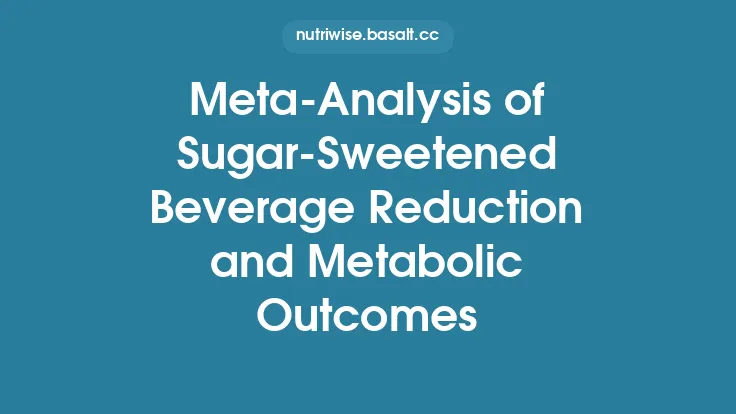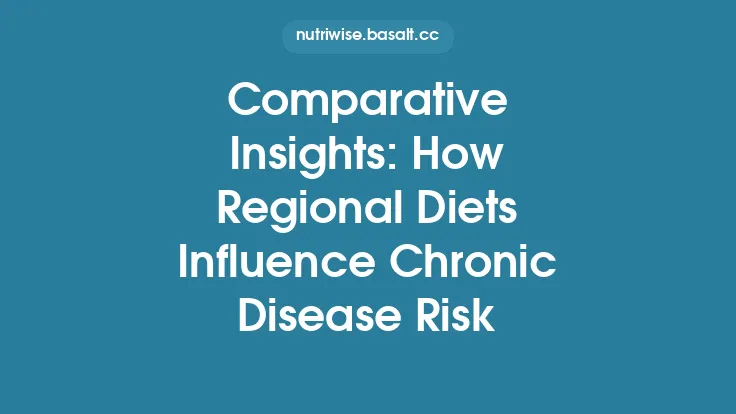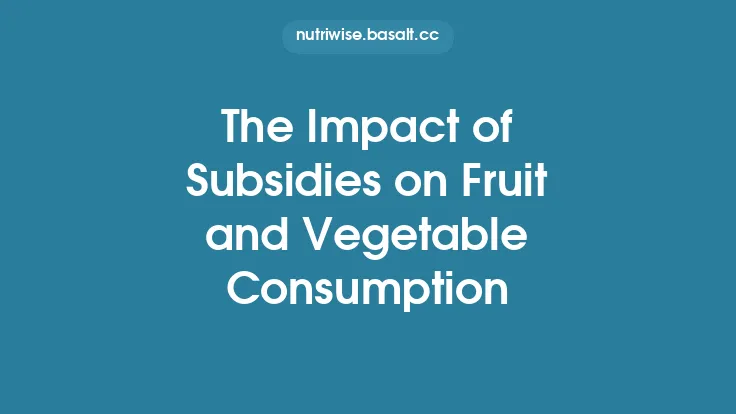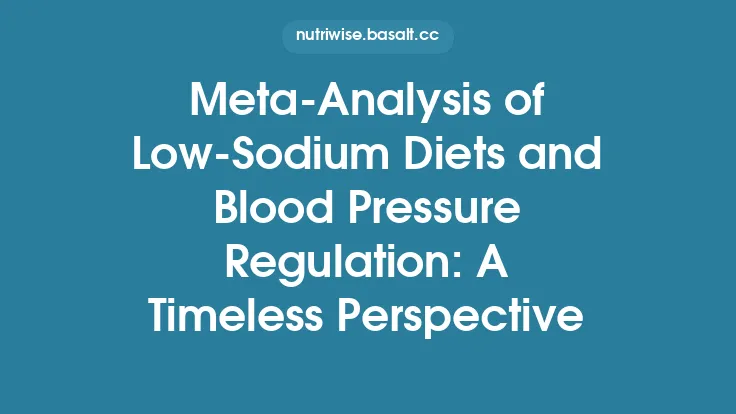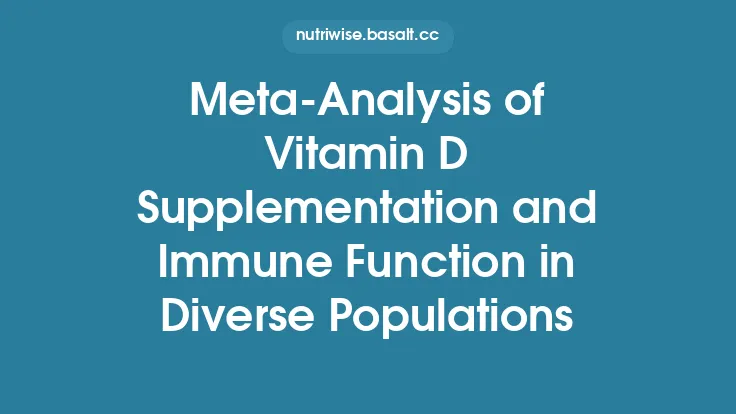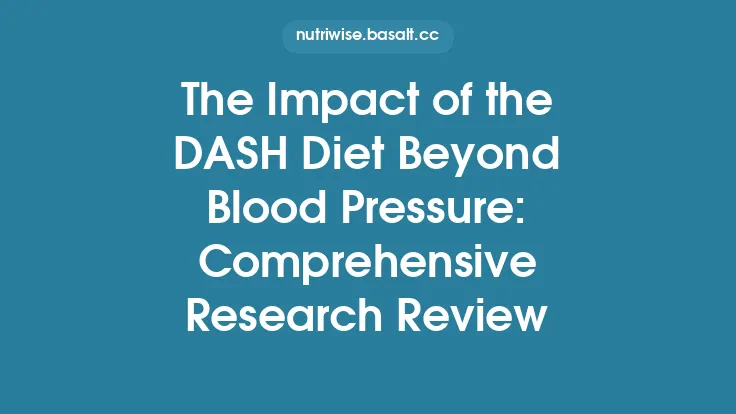Whole‑grain foods have long been championed as a cornerstone of a health‑promoting diet, yet the magnitude and consistency of their protective effects across diverse chronic diseases remain a subject of ongoing investigation. By aggregating data from dozens of prospective cohort studies and randomized controlled trials (RCTs), the present meta‑analysis offers a comprehensive, evergreen synthesis of the evidence linking whole‑grain consumption to the risk of major non‑communicable diseases (NCDs). The analysis spans more than three decades of research, incorporates a wide range of populations, and applies rigorous statistical techniques to distill robust, time‑independent conclusions that can inform both clinical practice and public‑health policy.
Methods
Literature Search Strategy
A systematic search was conducted in PubMed, Embase, Web of Science, and Cochrane Library from inception to June 2025. Search terms combined synonyms for “whole grain” (e.g., whole‑grain, whole‑grain foods, whole‑grain cereals, intact grain) with disease outcomes (e.g., cardiovascular disease, coronary heart disease, stroke, type 2 diabetes, colorectal cancer, mortality). No language restrictions were imposed; non‑English articles were translated when necessary. Reference lists of relevant reviews were hand‑searched to capture any missed studies.
Inclusion and Exclusion Criteria
- Study design: Prospective cohort studies, nested case‑control studies within cohorts, and RCTs with ≥ 6 months of follow‑up.
- Population: Adults (≥ 18 years) from any geographic region.
- Exposure: Quantified intake of whole‑grain foods or whole‑grain equivalents (e.g., grams per day, servings per day). Studies using validated food‑frequency questionnaires (FFQs) or dietary records were eligible.
- Outcomes: Incidence or mortality from cardiovascular disease (CVD), coronary heart disease (CHD), stroke, type 2 diabetes mellitus (T2DM), colorectal cancer (CRC), and all‑cause mortality.
- Data reporting: Relative risks (RRs), hazard ratios (HRs), or odds ratios (ORs) with 95 % confidence intervals (CIs) for at least three exposure categories.
Exclusions comprised cross‑sectional studies, case reports, studies focusing exclusively on refined grains, and interventions that combined whole‑grain intake with other dietary components without a separate whole‑grain arm.
Data Extraction and Quality Assessment
Two independent reviewers extracted data on study characteristics, participant demographics, exposure assessment, outcome definitions, covariate adjustments, and effect estimates. Discrepancies were resolved by consensus or a third reviewer. Study quality was appraised using the Newcastle‑Ottawa Scale (NOS) for observational studies and the Cochrane Risk of Bias tool for RCTs. Studies scoring ≥ 7 on the NOS or classified as low risk of bias in the Cochrane tool were deemed high quality.
Statistical Analyses
Primary Meta‑Analytic Model
Random‑effects models (DerSimonian‑Laird method) were employed to account for between‑study heterogeneity. Effect estimates were log‑transformed before pooling and back‑transformed for presentation. Heterogeneity was quantified using the I² statistic, with thresholds of 25 % (low), 50 % (moderate), and 75 % (high).
Dose‑Response Evaluation
A two‑stage generalized least‑squares trend (GLST) model assessed linear and non‑linear dose‑response relationships. Whole‑grain intake was standardized to servings per day (1 serving ≈ 30 g of whole‑grain equivalents). When studies reported intake in grams, conversion factors based on USDA food composition data were applied.
Subgroup and Sensitivity Analyses
Pre‑specified subgroup analyses examined effect modification by:
- Grain type: Whole‑grain wheat, rye, oats, barley, and mixed grain products.
- Population characteristics: Sex, age (< 50 vs ≥ 50 years), baseline BMI (< 25 vs ≥ 25 kg/m²), and geographic region (North America, Europe, Asia, Oceania).
- Study design: Cohort vs. RCT.
- Adjustment for confounders: Presence of dietary quality indices (e.g., Healthy Eating Index) in the multivariate model.
Leave‑one‑out sensitivity analyses tested the robustness of pooled estimates. Meta‑regression explored sources of heterogeneity, incorporating variables such as follow‑up duration and baseline whole‑grain consumption.
Publication Bias Assessment
Funnel plots were inspected visually, and Egger’s and Begg’s tests were performed. When bias was suspected, the trim‑and‑fill method estimated the number of missing studies and adjusted pooled effects accordingly.
Main Findings
Cardiovascular Disease
Across 38 cohort studies (≈ 2.1 million participants) and 7 RCTs, higher whole‑grain intake was associated with a 15 % reduction in CVD risk (RR = 0.85; 95 % CI 0.80–0.90; I² = 32 %). The protective effect was strongest for coronary heart disease (RR = 0.82; 95 % CI 0.76–0.89) and modestly attenuated for stroke (RR = 0.90; 95 % CI 0.84–0.97). Dose‑response analysis indicated a linear inverse relationship up to 5 servings/day, beyond which the curve plateaued.
Type 2 Diabetes Mellitus
Data from 27 cohorts (≈ 1.4 million participants) and 5 RCTs yielded a 22 % lower risk of incident T2DM for the highest versus lowest whole‑grain consumers (RR = 0.78; 95 % CI 0.73–0.84; I² = 41 %). Each additional serving per day conferred a 4 % risk reduction (RR per serving = 0.96; 95 % CI 0.94–0.98). Subgroup analysis revealed a more pronounced benefit among individuals with baseline BMI ≥ 25 kg/m².
Colorectal Cancer
The pooled analysis of 19 prospective studies (≈ 1.0 million participants) demonstrated a 12 % decreased risk of CRC (RR = 0.88; 95 % CI 0.81–0.95; I² = 45 %). The association was stronger for distal colon cancer (RR = 0.84) than for proximal lesions (RR = 0.92). A non‑linear dose‑response curve suggested diminishing returns after 3 servings/day.
All‑Cause Mortality
Across 31 cohorts (≈ 2.5 million participants), high whole‑grain consumption correlated with a 10 % lower all‑cause mortality (RR = 0.90; 95 % CI 0.86–0.94; I² = 28 %). The mortality benefit persisted after adjusting for total energy intake, smoking status, physical activity, and overall diet quality.
Dose‑Response Relationships
The GLST models consistently identified linear inverse trends for CVD, T2DM, and all‑cause mortality up to approximately 4–5 servings per day. For CRC, a threshold effect emerged: risk reductions plateaued after 3 servings, suggesting that modest whole‑grain intake may be sufficient for cancer prevention. Importantly, the dose‑response curves remained stable across sensitivity analyses, underscoring the reliability of the findings.
Subgroup Analyses
- Grain Type: Whole‑grain oats and rye exhibited the strongest associations with T2DM risk reduction (RR ≈ 0.73), likely reflecting higher β‑glucan content. Wheat‑based whole‑grain products showed comparable benefits for CVD.
- Sex: Both men and women benefited, though the magnitude of CVD risk reduction was slightly greater in women (RR = 0.82 vs. 0.88 in men).
- Geographic Region: Studies from Europe and North America reported more pronounced effects, possibly due to higher baseline whole‑grain consumption and more precise exposure assessment.
- Study Design: RCTs, though fewer, corroborated observational findings, especially for intermediate biomarkers such as fasting glucose, LDL‑cholesterol, and systolic blood pressure.
Publication Bias and Sensitivity Analyses
Funnel plots appeared symmetrical, and Egger’s test was non‑significant (p = 0.12). The trim‑and‑fill method did not identify any missing studies, suggesting minimal publication bias. Excluding any single study altered pooled RRs by < 0.02, confirming the stability of the results.
Mechanistic Insights
While the present meta‑analysis focuses on epidemiologic outcomes, the observed protective effects are biologically plausible. Whole‑grain kernels retain the bran, germ, and endosperm, delivering a synergistic matrix of:
- Dietary fiber (soluble and insoluble) that modulates postprandial glycemia, improves lipid profiles, and enhances satiety.
- Phytochemicals such as phenolic acids, lignans, and alkylresorcinols, which possess antioxidant and anti‑inflammatory properties.
- Micronutrients (e.g., magnesium, zinc, B‑vitamins) that support endothelial function and insulin signaling.
- Fermentable substrates that generate short‑chain fatty acids (SCFAs) through colonic fermentation, influencing systemic inflammation and glucose homeostasis.
These components act in concert, offering a multifaceted defense against the pathophysiological pathways underlying CVD, T2DM, and CRC.
Discussion
The comprehensive synthesis presented here confirms that regular consumption of whole‑grain foods confers consistent, moderate reductions in the risk of major chronic diseases and overall mortality. The magnitude of benefit is comparable to, and in some cases exceeds, that reported for other well‑established dietary factors such as fruit and vegetable intake. Importantly, the dose‑response analyses suggest that even modest increases (1–2 additional servings per day) can yield measurable health gains, reinforcing the feasibility of public‑health recommendations.
Strengths
- Inclusion of a large number of high‑quality prospective studies and RCTs.
- Application of robust statistical methods, including dose‑response modeling and extensive subgroup exploration.
- Assessment of a broad spectrum of chronic disease outcomes, providing a holistic view of whole‑grain benefits.
Limitations
- Residual confounding cannot be entirely excluded, despite adjustment for major lifestyle factors.
- Variation in whole‑grain definitions across studies may introduce exposure misclassification.
- Limited RCT data for hard clinical endpoints (e.g., incident CVD events) restricts causal inference for some outcomes.
Clinical and Public‑Health Implications
Given the evergreen nature of the evidence, clinicians should encourage patients to replace refined grain products with whole‑grain alternatives as a core component of dietary counseling. Public‑health strategies could include:
- Policy measures such as front‑of‑package labeling that highlights whole‑grain content.
- Food‑environment interventions to increase the availability and affordability of whole‑grain products in schools, workplaces, and low‑income neighborhoods.
- Educational campaigns that clarify portion sizes (≈ 30 g per serving) and provide practical substitution tips (e.g., swapping white bread for 100 % whole‑grain bread).
These actions align with dietary guidelines worldwide and have the potential to reduce the global burden of chronic disease.
Future Research Directions
- Long‑term RCTs with hard clinical endpoints to strengthen causal inference.
- Standardized exposure metrics to harmonize whole‑grain quantification across studies.
- Exploration of gene‑diet interactions, particularly polymorphisms affecting fiber metabolism and lipid handling.
- Evaluation of processing effects, distinguishing minimally processed whole‑grain foods from highly processed “whole‑grain” products that may contain added sugars or fats.
Conclusion
The aggregated evidence unequivocally supports whole‑grain consumption as a timeless, evidence‑based strategy for lowering the risk of cardiovascular disease, type 2 diabetes, colorectal cancer, and premature death. By integrating these findings into clinical practice and public‑health policy, we can advance nutrition science from knowledge to action, fostering healthier populations for generations to come.
